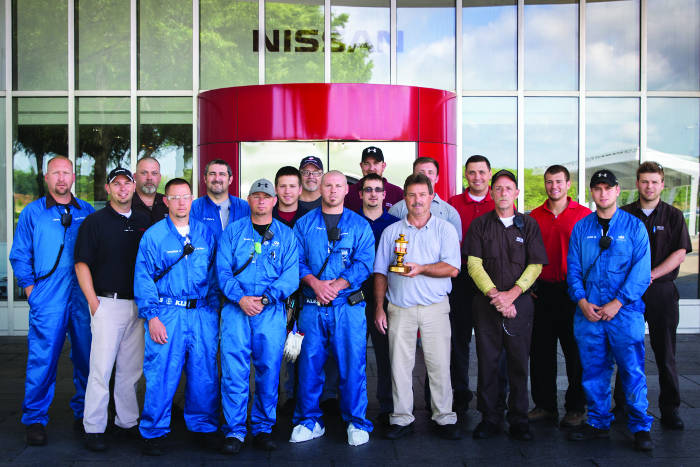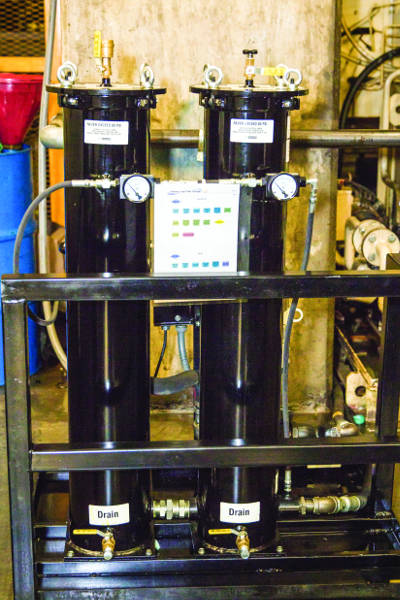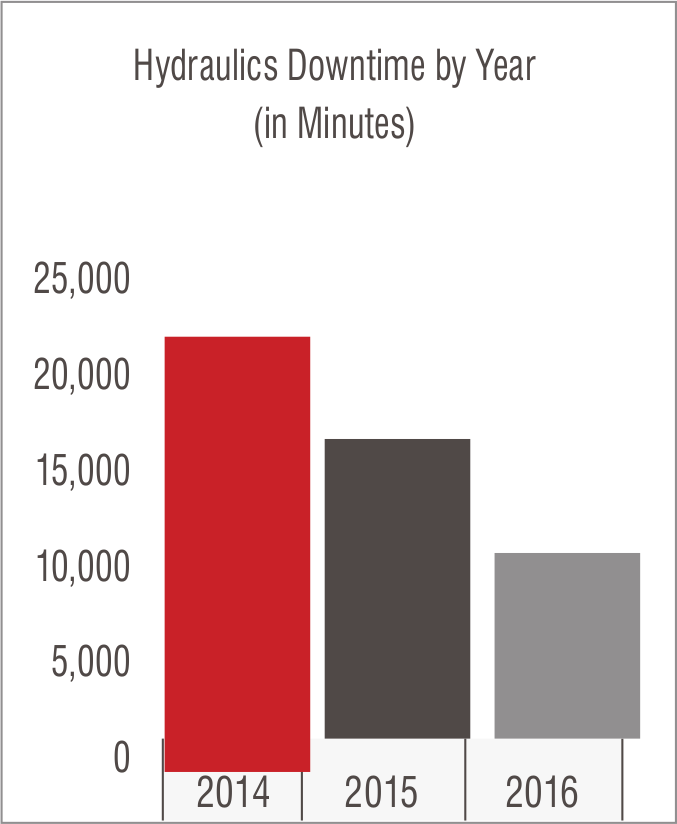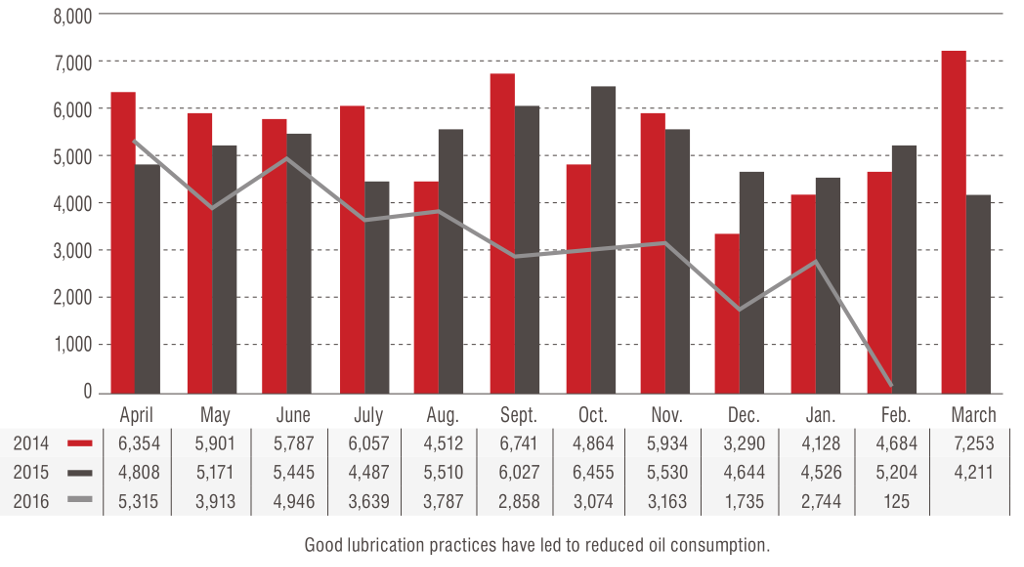Continuing the Journey to Lubrication Excellence

Nearly five years ago, the management team at Nissan saw the need to create a group that would lead the transition of its maintenance lubrication teams to a world-class level. In 2012, the Nissan stamping plant in Smyrna, Tennessee, succeeded in winning the John R. Battle Award from the International Council for Machinery Lubrication (ICML). Since that time, Nissan has developed a better mindset, emphasizing knowledge through education and training in the field of lubrication. Of course, even with a better outlook on lubrication, there are always opportunities to improve.
Training and Education
The initial focus at the Nissan stamping plant was on education and training. The lubrication management group plays a significant role in this area. They set up training classes with the lubrication teams and are the go-to guys for resolving any lubrication issues. Many technicians are now educated and trained in the lubrication field. Nissan provides Level I Machine Lubrication Technician (MLT I) training and certification testing through the ICML. Currently, the facility has 70-plus MLT I certifications. Additional training opportunities, including supplier-sponsored and online training, have been incorporated as well. The plant’s oil analysis expert has achieved his MLT I certification along with a Machine Lubricant Analyst (MLA) certification. He has been a big part of the lubrication program’s success. Nissan also has ongoing training to educate its technicians on the importance of using an ultrasonic grease gun when lubing a bearing. This training is provided by an in-house ultrasound expert.

Controlling Particle Contamination
 To address particle contamination, the plant concentrates on all new oil brought into the facility. Armed with the knowledge that new oil is not necessarily clean oil, the Nissan team has begun checking all received oil drums along with new bulk orders. With the new Karl Fischer testing system, the plant can now see if water is present in the oil. This is the appropriate way to determine whether good, clean oil is being received for the equipment.
To address particle contamination, the plant concentrates on all new oil brought into the facility. Armed with the knowledge that new oil is not necessarily clean oil, the Nissan team has begun checking all received oil drums along with new bulk orders. With the new Karl Fischer testing system, the plant can now see if water is present in the oil. This is the appropriate way to determine whether good, clean oil is being received for the equipment.
Another significant step Nissan has taken to control particle contamination has involved selecting the right grease application for all new conveyor chains. The best grease is now identified before new conveyor chains are purchased to eliminate any cross-contamination in the facility.
The stamping plant must also manage its unique open-lube systems, which expose many of the equipment’s vital parts to particle contamination. After a thorough investigation, it was determined that the most cost-effective way to control contamination was to use kidney-loop filtration. With these systems in place, particle contamination has been minimized, resulting in downtime being reduced by nearly 61 percent over 35 pieces of equipment. Achieving this type of reduction in downtime ensured management’s support for implementing the contamination control and improved lubrication practices strategy on all presses with this design.
Dirt Reduction
Nissan recently saw considerable cost savings by decreasing the dirt in its inline washing units. These units are used to reduce the number of contaminants before the forming process of surface parts. Previously, the filtration unit was a bag filter system, which was difficult to maintain, with a high cost for replacement filters. Oil testing also showed signs of degradation.
 After the issue was studied, it was decided to implement kidney loops for the washing oil filtration process. By installing a kidney-loop system, the plant found that management of the filters is easier to maintain and more cost efficient, as the filters can be changed quickly without having to shut down the line. This has resulted in a cost savings of $166,000 through less downtime, scrap reduction and overall quality.
After the issue was studied, it was decided to implement kidney loops for the washing oil filtration process. By installing a kidney-loop system, the plant found that management of the filters is easier to maintain and more cost efficient, as the filters can be changed quickly without having to shut down the line. This has resulted in a cost savings of $166,000 through less downtime, scrap reduction and overall quality.
A New Style of Preventive Maintenance
At this stage in the program, Nissan’s team had already tackled several of its biggest problems and had seen significant improvement in both uptime and employee morale. Moving on to address other important issues, the team evaluated the plant’s preventive maintenance (PM) and decided to introduce a new style of PM that would offer clear direction as to what was to be inspected, which lubricant to use and how much, as well as pictures for easy identification. The key was to engage all the technicians to assist in the process.
Now when PMs are generated and distributed, the technicians gather the necessary information from the equipment and write it on the PM. They also add any additional information about the equipment that may not be listed and mark off anything that does not apply. Calculations are then made to ensure that not only is the lubricant correct but also the quantities and application frequencies. This data along with the related pictures are put into the new format and released the next time the PM is performed. The PM-optimizing process has been a great opportunity for all personnel in the facility to strive for the best results with their lubrication practices.

Onsite Analysis
Another crucial component of Nissan’s lubrication program is its onsite laboratory, which has proven its effectiveness in predicting failures and monitoring current equipment conditions. The lab has analyzed and optimized existing routes, and established a schedule for them to be performed on a monthly basis. If a problem is discovered or a trend changes, the lab can adjust the equipment testing accordingly. This method has been successful in identifying problems and allowing the maintenance groups to plan repairs. With this process, the lab has freed up additional time, which is now used to evaluate new equipment that can be added to the routes, such as drop lifters and overhead conveyor drives.
Management Support
Having the support of technicians and management has been critical in Nissan’s success. Although the program is still very young, with strong roots in education, unquestionable management support for sustainability, standardization of procedures based on best practices, trending of critical metrics, use of information technology and a commitment to continuous improvement, the plant is definitely moving in the right direction.
